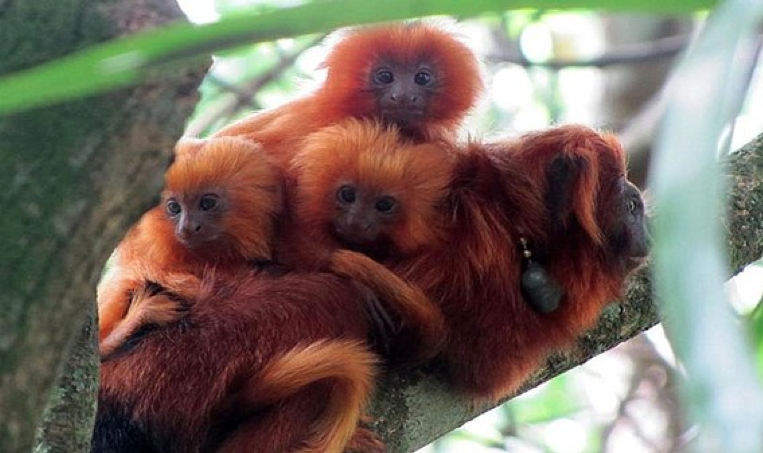1 October 2014
MEDIA RELEASE by SAVE THE GOLDEN LION TAMARIN
(contact@savetheliontamarin.org)
A recent census of Brazil’s endangered golden lion tamarins provides new hope for the species’ future
A 2014 census of endangered golden lion tamarins conducted throughout the species’ current geographic range in Rio de Janeiro, Brazil, indicates that 3,200 individuals—double the previous estimate—live in four separate forest fragments. Experts in the biology of small populations agree that this number of these tiny primates, if living in a single block of forest, would be sufficient to save the species from extinction.
Centuries of deforestation and unplanned urban expansion in Brazil’s Atlantic Coastal Rainforest reduced the golden lion tamarin’s lowland forest habitat by 98%. Remaining suitable forest was left in fragments, none large enough to support a viable tamarin population. In the 1980s, when efforts to conserve these monkeys were initiated in Brazil, only a few hundred individuals were thought to exist in nature—all in a single watershed 60 miles northeast of the rapidly expanding city of Rio de Janeiro.
For over three decades, scientists working with Brazil’s Associação Mico-Leão-Dourado (AMLD; Golden Lion Tamarin Association) have been reintroducing zoo-born golden lion tamarins and translocating tamarins rescued from threatened forests. AMLD also implemented long-term conservation education, sustainable agriculture and reforestation programs with local communities. Over time, illegal capture of tamarins and deforestation dropped to nearly zero in the region. The number of tamarins estimated living in nature climbed slowly to 1,000 in 2000, and to 1,600 in 2005. In 2003, the IUCN conservation status for the species was changed from “critically endangered” to “endangered”.
To conduct the 2014 census, AMLD scientists played prerecorded tamarin vocalizations to elicit responses from groups in forests throughout the species’ current geographic range, the São João River Basin, Rio de Janeiro state. Results indicate that 3,200 golden lion tamarins live in four separate forest fragments. This number of tamarins would be sufficient to save the species from extinction if the forest fragments are reconnected. AMLD is planting forest corridors on private lands to form these connections.
Dr. James Dietz, vice president of Save the Golden Lion Tamarin, a U.S. public charity created to support AMLD’s conservation work in Brazil said “I’m cautiously optimistic that AMLD will be able to reconnect just enough forest to keep golden lion tamarins from extinction for now. Given the intense development in the region, protecting that reconnected forest for the long term will require constant monitoring and adaptive management. If we want golden lion tamarins to have a future, our challenge is to make sure that AMLD is always there to look after them.”

Photo caption: Golden lion tamarin mother and her triplet offspring, a rare occurrence. Golden lion tamarins usually produce twins. The mother and father wear radio transmitter collars that permit AMLD managers to monitor the family group.
Photo credit: Andréia F. Martins, AMLD
